Evaluation of Subsidy Programmes
This research group focuses on two main research questions: (i) What is the causal effect of cooperative innovation activities on the performance of firms and regions? (ii) What are the causal effects of public Research and Development (R&D) support schemes on the performance of firms and regions? The first research question concerns the dynamics of firms and regions as a result of their different innovation activities. We apply a micro-based integrative perspective on innovative activities which allows identifying causal effects of cooperative activities on specific outcomes (e. g., patent applications, scientific publications, employment growth, or productivity growth). Concerning the second research question, recent studies mainly focus on the evaluation of one specific subsidy scheme. Research in this group aims to overcome this shortcoming by considering various support schemes. Indicators for the firms’ success are (amongst others) patent applications and employment growth. The results allow insights for the future design of innovation support schemes.
Centre for Evidence-based Policy Advice (IWH-CEP)
Research Cluster
Economic Dynamics and StabilityYour contact

Mitglied - Department Präsidialbereich
EXTERNAL FUNDING
09.2019 ‐ 09.2022
Establishing Evidence-based Evaluation Methods for Subsidy Programmes in Germany (EVA-KULT)
European Regional Development Fund (ERDF)
The project aims at expanding the Centre for Evidence-based Policy Advice at the Halle Institute for Economic Research (IWH-CEP).
01.2018 ‐ 12.2020
Networked growth - Innovative Saxony-Anhalt through digital business models (Competence Center 4.0)
Federal Ministry for Economic Affairs and Energy (BMWI)
01.2017 ‐ 12.2018
Political Participation in Eastern Germany
Federal Ministry for Economic Affairs and Energy (BMWI)
12.2015 ‐ 11.2018
Socio-economic Effects of Research on Innovative Approaches for POC Diagnostics
Federal Ministry of Education and Research (BMBF)
Part of the EXASENS project. Coordinated by the Leibniz Institute of Photonic Technology (IPHT) in Jena, nine Leibniz institutes are working together on researching point-of-care (POC) technology for the prediction and diagnosis of chronic inflammatory respiratory diseases. See press release.
02.2017 ‐ 02.2018
The Importance of Non-University Research Institutions for the Development of Firms and Regions (Be_For_Reg-Projekt)
Federal Ministry of Education and Research (BMBF)
01.2015 ‐ 12.2016
Evaluation of the "Joint Task 'Improving the Regional Economic Structure'" in the Federal State of Saxony-Anhalt
Investitionsbank Sachsen-Anhalt
Refereed Publications
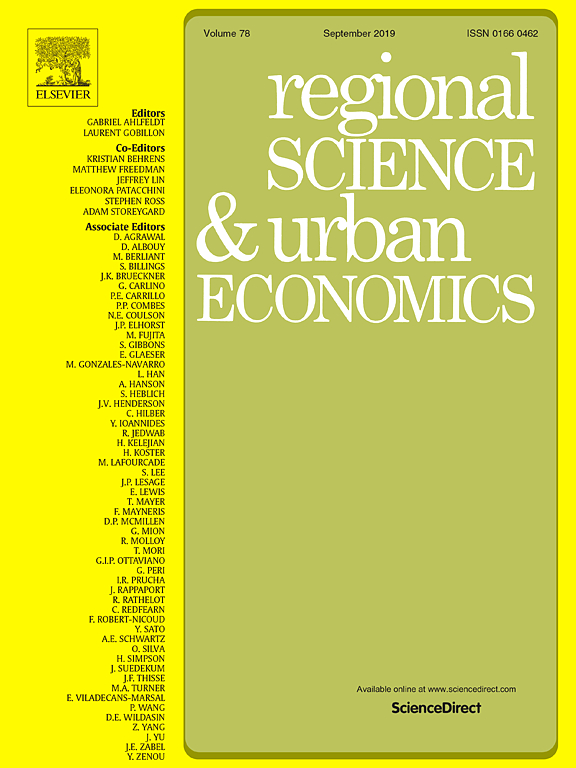
The Regional Effects of a Place-based Policy – Causal Evidence from Germany
in: Regional Science and Urban Economics, November 2019
Abstract
The German government provides discretionary investment grants to structurally weak regions in order to reduce regional inequality. We use a regression discontinuity design that exploits an exogenous discrete jump in the probability of regional actors to receive investment grants to identify the causal effects of the policy. We find positive effects of the programme on district-level gross value-added and productivity growth, but no effects on employment and gross wage growth.
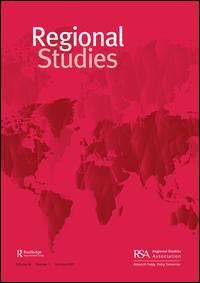
The Impact of Innovation and Innovation Subsidies on Economic Development in German Regions
in: Regional Studies, No. 9, 2019
Abstract
Public innovation subsidies in a regional environment are expected to unfold a positive economic impact over time. The focus of this paper is on an assessment of the long-run impact of innovation and innovation subsidies in German regions. This is scrutinized by an estimation approach combining panel model and time-series characteristics and using regional data for the years 1980–2014. The results show that innovation and innovation subsidies in the long run have a positive impact on the economic development of regions in Germany. This supports a long-term strategy for regional and innovation policy.
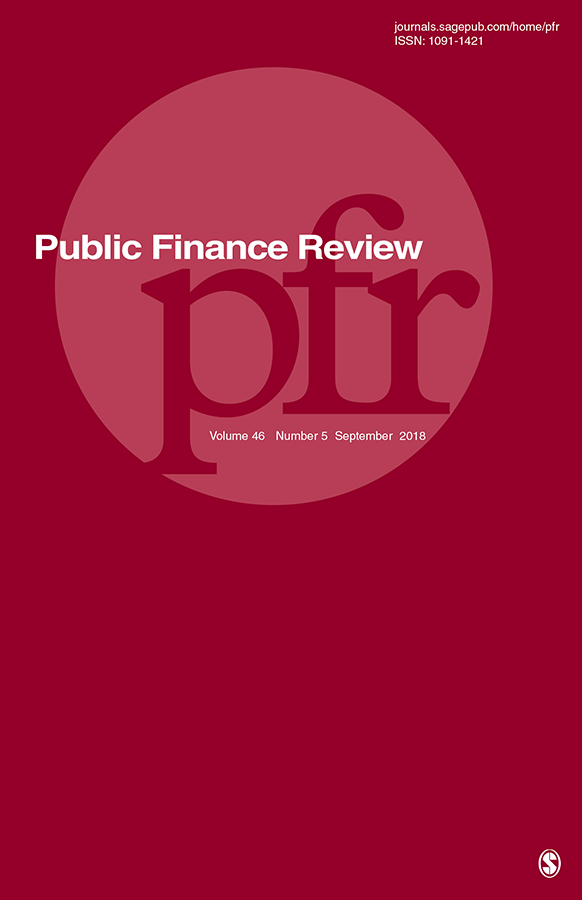
Vertical Grants and Local Public Efficiency
in: Public Finance Review, No. 3, 2019
Abstract
The existing empirical literature on the impact of vertical grants on local public-sector efficiency yields mixed results. Given the fact that vertical financial equalization systems often reduce differences in fiscal capacity, we argue that empirical studies based on cross-sectional data may yield a positive relationship between grants and efficiency of public service production even when the underlying causal effect is not. We provide a simple illustrative theoretical model to show the logic of our argument and illustrate its relevance by an empirical case study for the German state of Saxony-Anhalt. We show that our main argument of an inference-disturbing effect applies to those existing studies that are more optimistic about the impact of vertical grants. Finally, we argue that it may disturb the inference drawn from studies in a number of other countries where vertical grants—intended or not—concentrate in fiscally weak municipalities.

Do Diasporas Affect Regional Knowledge Transfer within Host Countries? A Panel Analysis of German R&D Collaborations
in: Regional Studies, No. 1, 2019
Abstract
Interactive regional learning involving various actors is considered a precondition for successful innovations and, hence, for regional development. Diasporas as non-native ethnic groups are regarded as beneficial since they enrich the creative class by broadening the cultural base and introducing new routines. Using data on research and development (R&D) collaboration projects, the analysis provides tentative evidence that the size of diasporas positively affects the region’s share of outward R&D linkages enabling the exchange of knowledge. The empirical analysis further confirms that these interactions mainly occur between regions hosting the same diasporas, pointing to a positive effect of ethnic proximity rather than ethnic diversity.
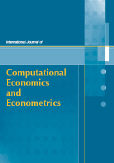
Innovation Cooperation in East and West Germany: A Study on the Regional and Technological Impact
in: International Journal of Computational Economics and Econometrics, 3/4 2018
Abstract
In this paper, we investigate the impact of regional and technological innovation systems on innovation cooperation. We develop an indicator applicable to regions, which demonstrates the relative regional impact on innovation cooperation. Applying this method to German patent data, we find that regional differences in the degree of innovation cooperation do not only depend on the technology structure of a region but also on specific regional effects. High-tech oriented regions, whether east or west, are not automatically highly cooperative regions. East German regions have experienced a dynamic development of innovation cooperation since re-unification in 1990. Their cooperation intensity remains higher than in West German regions.
Working Papers
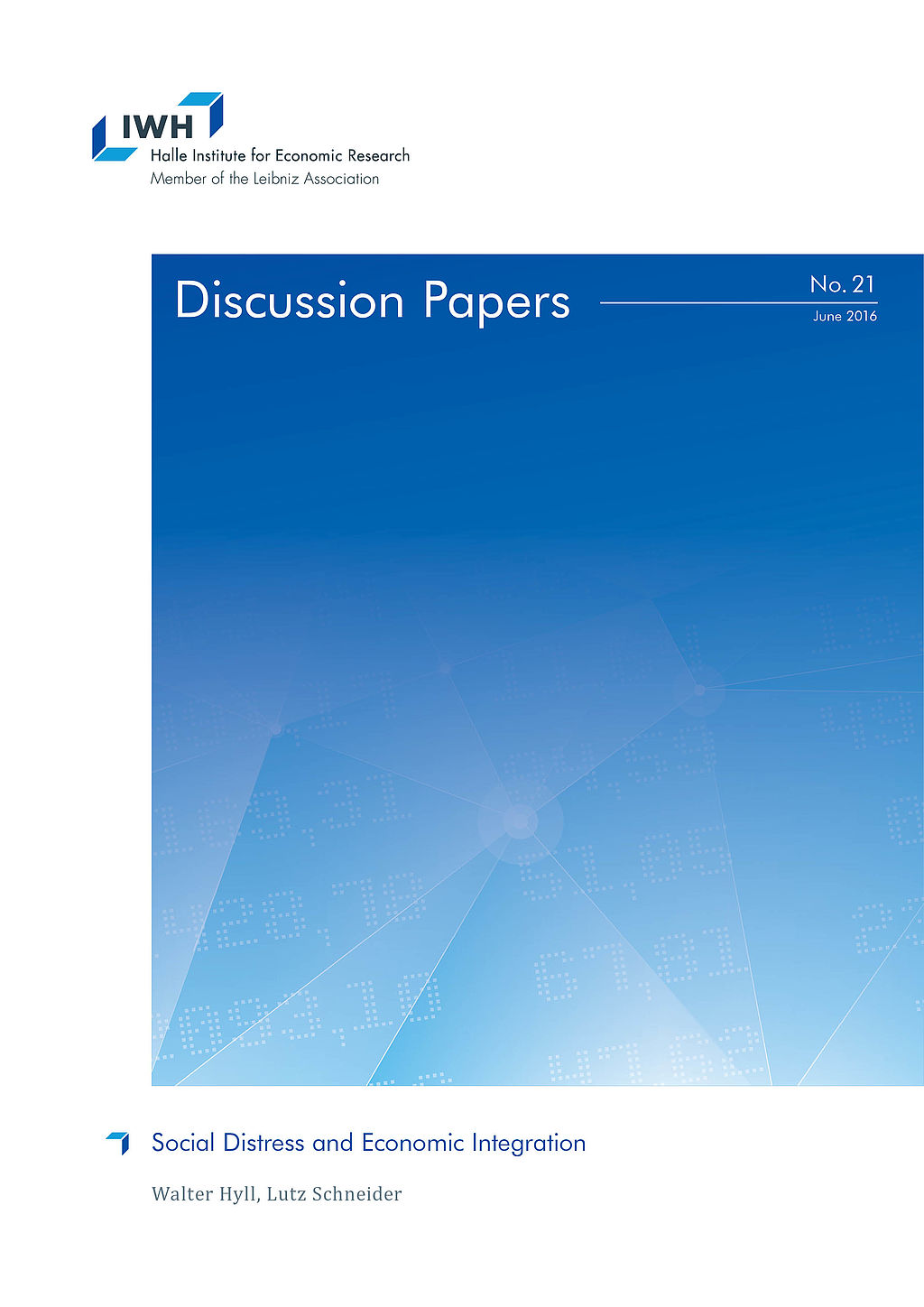
Do Manufacturing Firms Benefit from Services FDI? – Evidence from Six New EU Member States
in: IWH Discussion Papers, No. 5, 2015
Abstract
This paper focuses on the effect of foreign presence in the services sector on the productivity growth of downstream customers in the manufacturing sector in six EU new member countries in the course of their accession to the European Union. For this purpose, the analysis combines firm-level information, data on economic structures and annual national input-output tables. The findings suggest that services FDI may enhance productivity of manufacturing firms in Central and Eastern European (CEE) countries through vertical forward spillovers, and thereby contribute to their competitiveness. The consideration of firm characteristics shows that the magnitude of spillover effects depends on size, ownership structure, and initial productivity level of downstream firms as well as on the diverging technological intensity across sector on the supply and demand side. The results suggest that services FDI foster productivity of domestic rather than foreign controlled firms in the host economy. For the period between 2003 and 2008, the findings suggest that the increasing share of services provided by foreign affiliates enhanced the productivity growth of domestic firms in manufacturing by 0.16%. Furthermore, the firms’ absorptive capability and the size reduce the spillover effect of services FDI on the productivity of manufacturing firms. A sectoral distinction shows that firms at the end of the value chain experience a larger productivity growth through services FDI, whereas the aggregate positive effect seems to be driven by FDI in energy supply. This does not hold for science-based industries, which are spurred by foreign presence in knowledge-intensive business services.

Isolation and Innovation – Two Contradictory Concepts? Explorative Findings from the German Laser Industry
in: IWH Discussion Papers, No. 1, 2015
Abstract
We apply a network perspective and study the emergence of core-periphery (CP) structures in innovation networks to shed some light on the relationship between isolation and innovation. It has been frequently argued that a firm’s location in a densely interconnected network area improves its ability to access information and absorb technological knowledge. This, in turn, enables a firm to generate new products and services at a higher rate compared to less integrated competitors. However, the importance of peripheral positions for innovation processes is still a widely neglected issue in literature. Isolation may provide unique conditions that induce innovations which otherwise may never have been invented. Such innovations have the potential to lay the ground for a firm’s pathway towards the network core, where the industry’s established technological knowledge is assumed to be located. The aim of our paper is twofold. Firstly, we propose a new CP indicator and apply it to analyze the emergence of CP patterns in the German laser industry. We employ publicly funded Research and Development (R&D) cooperation project data over a period of more than two decades. Secondly, we explore the paths on which firms move from isolated positions towards the core (and vice versa). Our exploratory results open up a number of new research questions at the intersection between geography, economics and network research.

Does Proximity Matter in the Choice of Partners in Collaborative R&D Projects? – An Empirical Analysis of Granted Projects in Germany
in: IWH Discussion Papers, No. 12, 2014
Abstract
This paper contributes to the discussion on the importance of physical distance in the emergence of cross-region collaborative Research and Development (R&D) interactions. The proximity theory, and its extensions, is used as a theoretical framework. A spatial interaction model for count data was implemented for the empirical analysis of German data from the period from 2005 to 2010. The results show that all tested proximity measurements (geographical, cognitive, social and institutional proximity) have a significant positive influence on collaboration intensity. The proximity paradox, however, cannot be confirmed for geographical, social and institutional proximity, but for cognitive proximity.

Is Subsidizing Companies in Difficulties an Optimal Policy? An Empirical Study on the Effectiveness of State Aid in the European Union
in: IWH Discussion Papers, No. 9, 2014
Abstract
Even though state aid in order to rescue or restructure ailing companies is regularly granted by European governments, it is often controversially discussed. The aims for rescuing companies are manifold and vary from social, industrial and even political considerations. Well-known examples are Austrian Airlines (Austria) or MG Rover (Great Britain). Yet, this study aims to answer the question whether state aid is used effectively and whether the initial aim why aid has been paid has been reached, i.e. the survival of the company. By using data on rescued companies in the EU and applying a survival analysis, this paper investigates the survival rates of these companies up to 15 years after the aid has been paid. In addition, the results are compared to the survival rates of non-rescued companies which have also been in difficulties. The results suggest that despite the financial support, business failure is often only post-poned; best survival rates have firms with long-term restructuring, enterprises in Eastern Europe, smaller firms and mature companies. However, non-funded companies have an even higher ratio to go bankrupt.
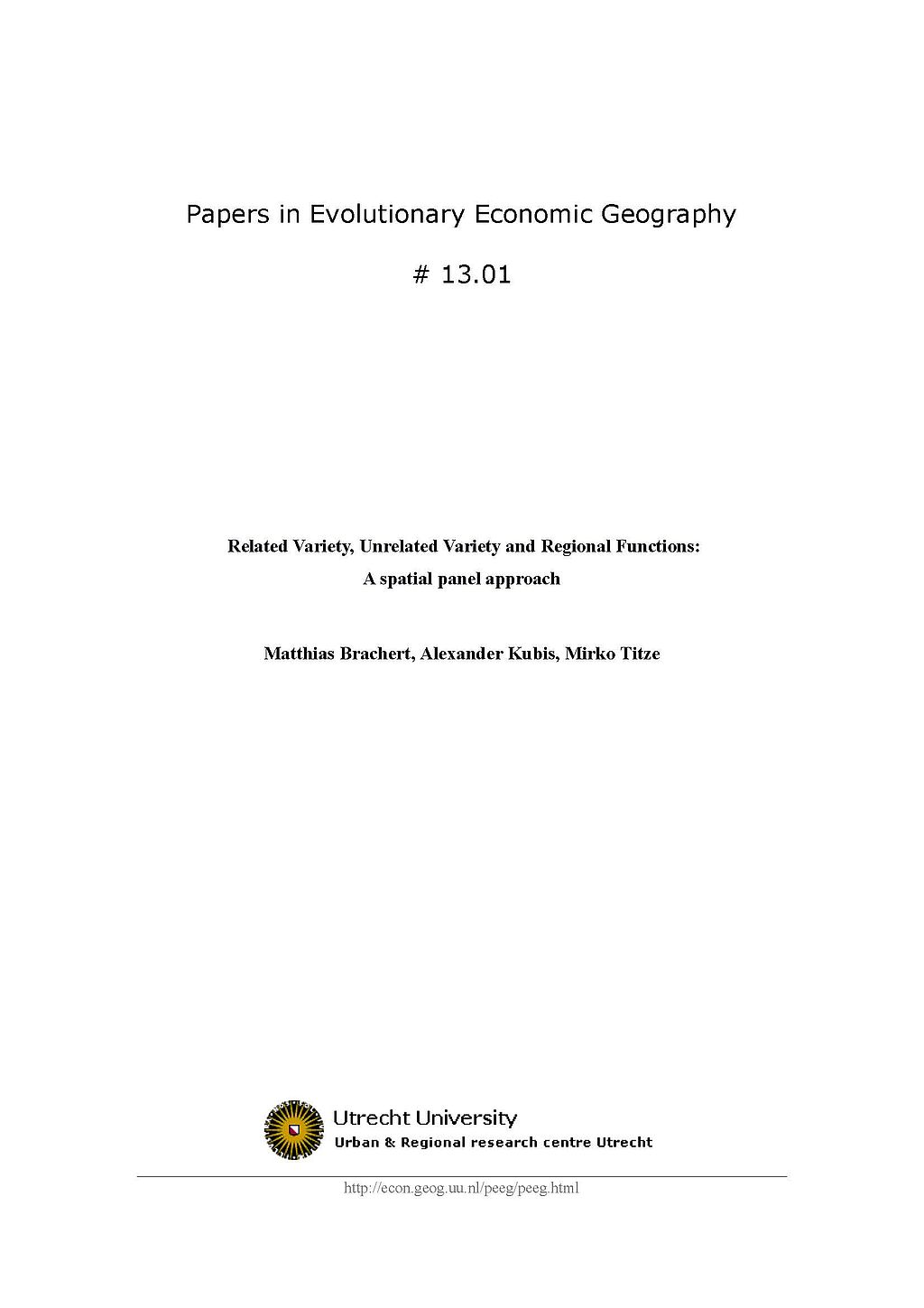
Related Variety, Unrelated Variety and Regional Functions: A spatial panel approach
in: Papers in Evolutionary Economic Geography, 2013
Abstract
The paper presents estimates for the impact of related variety, unrelated variety and the functions a region performs in the production process on regional employment growth in Germany. We argue that regions benefit from the existence of related activities that facilitate economic development. Thereby the sole reliance of the related and unrelated variety concept on standard industrial classifications (SIC) remains debatable. We offer estimations for establishing that conceptual progress can be made when the focus of analysis goes beyond solely considering industries. We develop an industry-function based approach of related and unrelated variety and test our hypothesis by the help of spatial panel approach. Our findings suggest that related variety as same as unrelated variety facilitate regional employment growth in Germany. However, the drivers behind these effects do differ. While the positive effect of related variety is driven by high degrees of relatedness in the regional “R&D” and “White-Collar”-functions, the effects of unrelated variety are spurred by “Blue Collar”-functions in this period.














